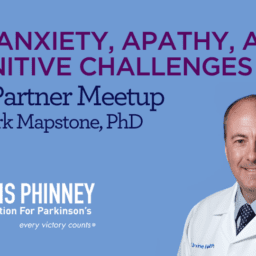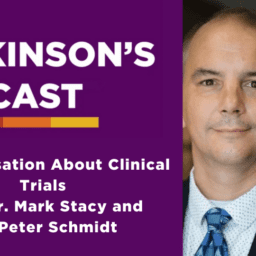Developing new treatments and advancing the understanding of Parkinson’s requires clinical trial development that takes all ages, stages, and individuals with Parkinson’s into account. It also requires people to raise their hands and participate. In this primer, we share the basics of clinical trials, how to evaluate trials, and information on trials for those living with young onset Parkinson’s disease (YOPD).
The Basics of Clinical Trials
There are two main categories of clinical studies: observational and interventional. The term “clinical trial” is often used to refer to both types of study.
Observational Studies
In observational studies/trials, researchers aim to learn new information by taking samples or making physical observations. Some observational trials, like the PPMI or LEOPARD-PD, primarily gather information from participants via surveys. In observational trials, researchers may also take body fluids or tissue samples. These samples are investigated for various purposes, including testing for genetic variants or searching for biomarkers.
Interventional Studies/Clinical Trials
In interventional studies/trials, researchers aim to determine the efficacy of a treatment. Interventional trials involve pharmaceutical or other physical interventions, like exercise regimens or diets.
Inclusion and Exclusion Criteria
Every trial has inclusion and exclusion criteria that describe who is eligible to participate in the trial. Common criteria for inclusion or exclusion for Parkinson’s-related studies are age, time since diagnosis, current medications, pregnancy status, UPDRS scores, Hoehn and Yahr stage, and whether the prospective participant has taken dopaminergic therapy like levodopa.
Phases
Interventional trials occur in multiple phases.
Phase one trials determine whether the intervention is generally safe or if there are significant adverse events. Phase two trials evaluate the safety and efficacy of the intervention for people living with the condition the intervention is intended to treat. Phase three trials increase the size of the group receiving the intervention to gain better data about the efficacy of the intervention. Some trials go to a fourth phase. This occurs if the results of the earlier phases suggest a need for more thorough data, usually about a particular aspect of the intervention being tested.
Arms, Placebos, and Blinding
Many clinical trials randomly allocate participants into different “arms.” Participants in different arms of a trial receive different treatments; different doses of the same treatment; a placebo; or, in some cases, no treatment.
The placebo or no-treatment arm of a trial improves the quality of conclusions that researchers make because placebos provide a way to compare the outcomes of using the treatment being investigated to the outcomes of not using the treatment. Some researchers argue that there are ethical concerns about the use of placebos and that there are better ways to improve the quality of data, like comparing the “best available therapy” to the intervention being tested.
When investigators or participants in a trial are said to be “blind,” it means they don’t know what arm of the trial any participant is in. Trials that do not feature blinding are called “open label.” Open-label trials may be appealing to participants because the participants will know what intervention they receive, but these trials often produce results of limited utility due to the lack of a control group.
Safety and Informed Consent
No clinical trial is without risk, and every reputable trial will involve an informed consent process when participants are informed of the risks and potential benefits of the trial.
Each trial should have systems in place that protect the welfare of trial participants. The most significant is the independent Institutional Review Board (IRB), which reviews trial design before a study can begin at a research institution. Many trials—especially later-phase trials—also have a Data and Safety Monitoring Board (DSMB), an independent group of experts who monitor trial data collection. In part, the DSMB monitors data to determine whether adverse events or efficacy data suggest the trial should be changed or terminated.
Approval Process
Most new pharmaceutical interventions require two successful phase-three trials for the intervention to be approved by regulatory agencies for use outside the clinical trial setting. However, when an intervention in a phase-three trial accomplishes something that no available treatment can accomplish, approval is sometimes granted based on a single successful phase-three trial.
How to Find Trials
Clinicaltrials.gov and the Fox Trial Finder are the best resources for finding trials. Your movement disorder specialist is also a great resource because they will know what trials will be starting soon near your location. Additionally, many Parkinson’s clinics and hospitals that engage in research post information about ongoing trials on their websites.
How to Evaluate Clinical Trials
Your Priorities and Motivations
When deciding whether to participate in a trial, your priorities and motivations are the most important aspects to consider. One of the best and most common reasons to participate in a trial is to help others, and if this is your motivation, you should choose to participate in those trials where you and your care team think participation will be most helpful to you and others.
Have Reasonable Expectations
You might be motivated to participate in trials because you want early access to new treatments, especially treatments that hope to alter the progression of Parkinson’s; however, you should keep in mind that such trials sometimes last for multiple years and often have higher levels of risk. Moreover, you should enter these trials understanding that approximately 90% of clinical trials do not result in a new treatment being approved.
Your Medications
Think carefully about whether a trial’s requirements regarding medications will be tolerable for you. Talk with your care team about whether they think the requirements are appropriate to your circumstances and the expectations they have for the rate at which your Parkinson’s may progress.
The Timing
Participating in a trial can be time consuming. It may involve travel and long days in a clinic. Consider whether the time required for the trial will be manageable for you relative to the other parts of your life.
Possible Future Limitations
Participating in some trials—for example, gene therapy trials or other trials that aim to modify the progression of Parkinson’s—might cause you to be excluded from future trials.
Your Risk Tolerance
Be sure to evaluate any trial you are considering participating in to determine if the risks are tolerable. Because there will always be some risk to participation, also discuss trial participation with your care team. One way to do this is to share the materials about the trial that are available from clinicaltrials.gov and on the trial’s website.
Here are four factors that affect the risks of participation in a trial.
#1 – Type of Trial
Generally, observational trials involve less risk than interventional trials.
#2 – Type of Intervention
Trials investigate various types of interventions. Some trials—for example those involving gene therapy, new DBS systems, or stem cell therapy—may involve surgery, and this elevates risk. Other trials may involve taking a repurposed drug, and there is usually substantial safety data about these treatments, so the risks are relatively well known. In trials that involve exercise, there will be an elevated risk of orthopedic or other injuries.
#3 – Phase of Trial
Early-phase trials tend to be riskier than late-stage trials. By the time a new intervention reaches phase three or phase four, many of the physical risks of the intervention are known, and these should be reported to prospective participants during the informed consent process.
#4 – The Chance of Receiving a Placebo
It can be tempting to join an interventional trial because of the possibility that the treatment being investigated will be very effective at treating symptoms or alter the progression of Parkinson’s. However, in most high-quality studies, there will be a chance that you could receive a placebo. In some studies, the possibility of receiving a placebo may be as high as 50%. Before you enroll in a trial, make sure that you would be okay no matter what arm of the trial you are enrolled in. Also, be sure to ask the trial team if there is an option for you to receive the treatment after the trial if you both learn that you initially received the placebo. That is standard practice for some trials.
Notes on Trial Participation for People Living with YOPD
Many clinical trials for Parkinson’s exclude people with young onset Parkinson’s disease (YOPD). Reasons for this include that fewer people are living with YOPD than with later-onset Parkinson’s and that people living with YOPD tend to have slower progression. These and other nuances of YOPD can complicate data analysis and the conclusions that researchers can reach at the end of the trial. Accordingly, trials that include people with YOPD are often more extensive studies that occur at multiple sites.
The authors of a 2020 study in the Journal of Parkinson’s Disease write that “the paucity of trials that only include people with YOPD calls for studies…focused on treatment effects in YOPD. Such evidence is urgently needed as input during shared-decision processes between doctors and patients.” As a person living with YOPD, you can help address the urgent need for more evidence by participating in the studies that allow participants living with YOPD. The more participants with YOPD a study has, the more broadly meaningful the conclusions the study reaches will be.
Some considerations are especially significant for people living with YOPD:
Timing and Progression
Trials that aim to alter the course of Parkinson’s may be especially interesting for people living with YOPD. Since they are likely to live with Parkinson’s for many years, they often have amplified interest in slowing progression as much and as early as possible.
However, trials that aim to alter progression are often longer, and many office visits may be required. Additionally, these trials often restrict what non-study medications participants can take. Because people living with YOPD often have busy lives, these details can become burdensome as personal circumstances evolve. Additionally, you should bear in mind that there is no guarantee that the treatments being investigated will prove effective.
Parenting and Exclusion Criteria
One specific timing concern for people living with YOPD is that trials often exclude people who are breastfeeding or who may be trying to conceive a child.
Future Limitations
Participating in a trial for a promising intervention today might exclude you from participating in a similar trials in the future. Discussing these possibilities and your personal priorities with your care team and your family can be helpful in navigating these issues.
Expanding Your Care Team
Getting to know other Parkinson’s specialists through trial participation can help ensure continuity of care if you have to find a new member of your care team due to retirement, relocation, or any other reason.
Reasons to Participate in Studies
Despite the possibility of receiving a placebo and the fact that most clinical trials do not result in a new treatment being approved for use, there are four reasons for people with YOPD to participate in trials:
#1 – More Time with Care Providers and More Frequent Feedback
Participating in a trial gives you more opportunities to consult with and learn from expert care providers. Additionally, you will likely have assessments at each trial visit, so you will get more frequent feedback regarding the rate at which your Parkinson’s is progressing.
#2 – New Social Engagements
When you participate in a trial, you will meet new people and have new social experiences. These are important ways to live well today because social isolation can exacerbate Parkinson’s symptoms.
#3 – Exposure to Cutting Edge Science, Innovations, and Possibly New Treatments
By participating in an interventional trial, you will have the opportunity to learn about innovative approaches to treating and living well with Parkinson’s. Many participants in trials find it energizing and fun to be on the cutting edge of science. And although the chance is small, it is also possible that you will get early access to a new, groundbreaking therapy.
#4 – Generosity, Empowerment, and Progress: Improve Understanding of Parkinson’s
There are few certainties with clinical trials, but one of them is that participating in a clinical trial is a profoundly generous act, and this generosity will improve understanding and treatment of Parkinson’s in the long term. Because of this, many people find participating in trials to be empowering.
Parkinson’s can feel out of your control, but when you participate in a trial, you take action that will lead the way to a better understanding of Parkinson’s, new treatments, and, ultimately, a cure.
 JOIN OUR PELOTON CLUB
JOIN OUR PELOTON CLUB
Our educational content is made possible because of the monthly donors in our Peloton Club. Want to become a member and help us continue to create the resources people need to live well with Parkinson’s? Learn more and register to become a member here. (You’ll get a cool gift if you do!) It’s as easy as can be to set it and forget it.

















